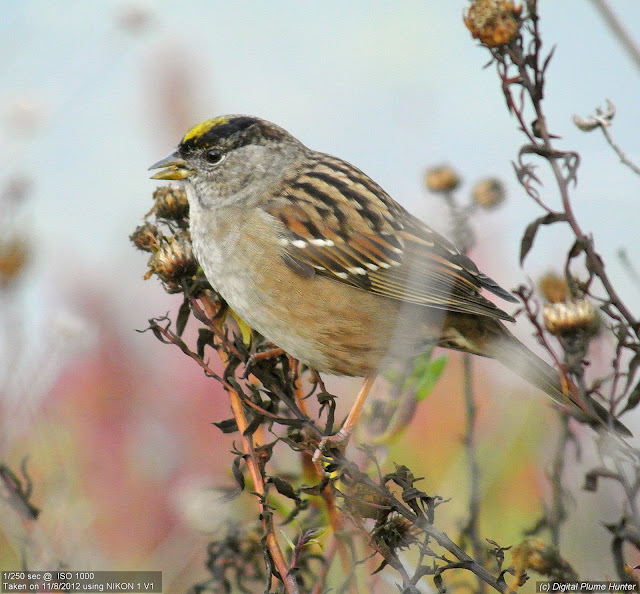[San Francisco Bay Area, California. November 2012]
The American Bushtit is the only member of the Bushtit or long-tailed tit family (consisting of 11 species) that is found in North America; all the other 10 species are found in Eurasia.
What's interesting about the American Bushtit is that it is possible to tell the sexes apart by the color of their eyes -- the male [shown above] has dark eyes while the female has distinctive pale-yellow eyes.
These tiny, 3 inch, birds are highly gregarious, preferring to feed and move about in small flocks. They are classified as "Least Concern" and range widely in the West and Southwest regions and even into Texas.
Other birds that are found at Lucy Evans Baylands Nature Center include shorebirds, waterfowl and sparrows -- a few of which will be described here.
First the Golden-crowned Sparrow, this is exclusively a Western sparrow that breeds in Alaska and Northwest Canada and winters on the West Coast.
It is one of our least studied sparrows and there is a dearth of information about its life history. It would make an excellent subject for study by a budding ornithologist. The other crowned sparrow found at Bylands is the White-crowned Sparrow:
This sparrow is much more widespread and winters broadly over much of the US.
Less striking perhaps is the song sparrow; it is unique in that it has highly variable coloring and streaking across its range where 24 subspecies and 52 forms have been identified [see All about birds article].
Another bird with a large range is the House Finch -- this American finch is found in both red and orange/yellow variants. Originally purely confined to the West, it has been slowly expanding its range since the 60's and is now found widely across the country; even on the East Coast where it was formerly unknown.
Moving from finches to warblers: the most common warbler in the area is Audubon's Warbler (yellow-rumped with yellow throat). This is a familiar and our most wide ranging warbler that comes in 2 forms -- Myrtle and Audubon's [seen here]. They were earlier thought to be two separate species but are now considered conspecific. Given that the winds of taxonomic research blow in mysterious ways, it is quite possible that in the future they will be separated again.
Finally, black phoebe -- this Western flycatcher ranges all the way from California down to South America. It nests in cliffs and is even known to sometimes catch small fish. Together with Say's phoebe, it is the most common flycatcher seen in the West.
North America's only long-tailed tit and our only crowned sparrows: the golden and the white represent highlights of a quick trip to Baylands Preserve.
The American Bushtit is the only member of the Bushtit or long-tailed tit family (consisting of 11 species) that is found in North America; all the other 10 species are found in Eurasia.
What's interesting about the American Bushtit is that it is possible to tell the sexes apart by the color of their eyes -- the male [shown above] has dark eyes while the female has distinctive pale-yellow eyes.
These tiny, 3 inch, birds are highly gregarious, preferring to feed and move about in small flocks. They are classified as "Least Concern" and range widely in the West and Southwest regions and even into Texas.
Other birds that are found at Lucy Evans Baylands Nature Center include shorebirds, waterfowl and sparrows -- a few of which will be described here.
First the Golden-crowned Sparrow, this is exclusively a Western sparrow that breeds in Alaska and Northwest Canada and winters on the West Coast.
It is one of our least studied sparrows and there is a dearth of information about its life history. It would make an excellent subject for study by a budding ornithologist. The other crowned sparrow found at Bylands is the White-crowned Sparrow:
This sparrow is much more widespread and winters broadly over much of the US.
Less striking perhaps is the song sparrow; it is unique in that it has highly variable coloring and streaking across its range where 24 subspecies and 52 forms have been identified [see All about birds article].
Another bird with a large range is the House Finch -- this American finch is found in both red and orange/yellow variants. Originally purely confined to the West, it has been slowly expanding its range since the 60's and is now found widely across the country; even on the East Coast where it was formerly unknown.
Moving from finches to warblers: the most common warbler in the area is Audubon's Warbler (yellow-rumped with yellow throat). This is a familiar and our most wide ranging warbler that comes in 2 forms -- Myrtle and Audubon's [seen here]. They were earlier thought to be two separate species but are now considered conspecific. Given that the winds of taxonomic research blow in mysterious ways, it is quite possible that in the future they will be separated again.
Finally, black phoebe -- this Western flycatcher ranges all the way from California down to South America. It nests in cliffs and is even known to sometimes catch small fish. Together with Say's phoebe, it is the most common flycatcher seen in the West.
North America's only long-tailed tit and our only crowned sparrows: the golden and the white represent highlights of a quick trip to Baylands Preserve.










No comments:
Post a Comment